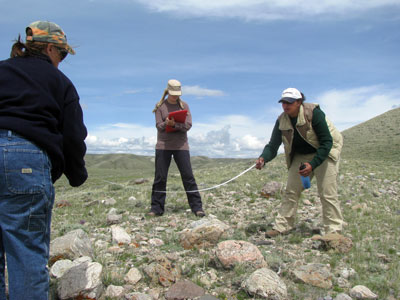CWC grad digging archeology
January 1, 2011

Personal tragedy greatly changed the direction in the life of one recent Central Wyoming College graduate.
When Gale Brow’s husband, Pat, died from pneumonia shortly after an oil rig accident at age 50, Gale realized she needed to make some changes or she would continue to dwell on ways she could have prevented his untimely death.
“I decided I had to do something physical,” she recalled. “I needed to keep my mind from wandering off.” A medical transcriptionist in Evanston for 30 years, Gale said her work had become mundane and her mourning was intensified by her guilt.
She decided to move home to Riverton and live with her aging mother, Peg Minick. Following a lifelong passion, she enrolled in archeology courses that were part of CWC’s fledgling Western American Studies program. Gale is a big fan of the History Channel’s Simcha Jacobovici, who strips away historical myths by probing some of the most controversial theories of Biblical archeology, as well as British archaeologist John Romer.
She, too, wants to travel to distant lands, dig up history and get paid for work she loves. In May, Gale graduated with highest honors and was one of four valedictorians in CWC’s class of 2011. Instead of thinking about retirement, Gale is now looking to complete a bachelor’s and master’s degree at the University of Wyoming.
“My father would be so proud of this college that he helped start,” she said of the late Elliott Minick, who was one of the founders of CWC. “It is just so pro-student. My dad would be so tickled.”
She feels lucky that she was part of the program when the college opened the Intertribal Education and Community Center. “We got to set up the museum,” she announced with pride. Artifacts that CWC students unearthed during field study courses as well as the Stewart Collection of Indian artifacts were moved into the building. The students also played a role in the selection of the historical photos and other displays in the center.
Gale enrolled at CWC at the same time Todd Guenther, former South Pass and Lander Pioneer Museum curator, was hired to develop the Western American Studies program. It didn’t take long for Guenther to get her totally fascinated by the subject.
“How long does it take for Todd Guenther to talk before you’re totally sucked in?” she jokingly asked. “He has such a passion for what he teaches.”
Participating in Guenther’s annual summer field studies program along the Oregon and California Trails continued to fuel her enthusiasm for the subject. The program had received a research grant from the National Park Service to study archaeological sites along the middle and upper Sweetwater River. During the 2010 field study the students discovered more than 50 previously undocumented sites and trail segments.
While sitting around a camp fire at field school, Guenther read an article to the field school participants that had been published in a California/Oregon Trail Association newsletter detailing the story of two men who had reportedly been killed by Indians along the Seminoe Cutoff in 1862.
The article indicated the men, brothers-in-law originally from Illinois, had been buried by members of the Ohio Calvary above Alkali Creek which was just a few miles from the students’ camp.
Diary entries included in the article indicated the cavalry men who came upon the grave discovered a loyal dog “almost starved to death” lying at the head of its master’s grave.
“I tried to coax him to go with me, but all in vain,” the diary entry said. “I gave him provisions enough to last him several days and then left him still by the grave.”
Brow said the students and Guenther chatted for hours about what might have happened to the dog and the others in the wagon train.
“In those diaries, there were numerous stories of others that had experienced one tragedy after another,” she said. “It became evident that death was simply a way of life along the trail.”
The following the morning, the students began their search for the graves. They decided it held significant historical value and the group ventured out to locate it. “What were the odds that we would be able to locate this particular site?” Brow asked. “We understood that it was possible, but not necessarily probable.”
Ironically, she said they “walked right up” to the grave the next day. She recalls the group just stood and grinned at each other, recognizing that no one in modern times had located the emigrants’ final resting place.
The investigation by the team of students resulted in a paper Gale presented recently to the Wyoming Association of Professional Archeologists (WAPA). She was awarded a scholarship for her efforts as well as funds for her to conduct independent research on CWC’s Sinks Canyon Center archaeology. Three other CWC students and a CWC graduate also presented papers to the WAPA.
A similar group of students made presentations at the WAPA meeting the year before and Gale then shared her research on the history and archeology of the college’s Sinks Canyon Center.
The presentations put the students in contact with professional and academic archeologists from around the region which opened doors to scholarships, work and additional hands-on experiences.
Last summer, Gale and fellow student Rita Bolton, were hired by the Wyoming State Archeologist to conduct a study near Hoback Junction. She is hoping funds are available for them to continue the dig on what she calls a “multicultural paleo-Indian site” this summer.
Gale credits her parents and her late husband for her love of history and archeology. As a child, she recalls her family spending weekends along the Sweetwater. “It was something I grew up with. It’s in my blood.”